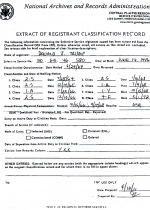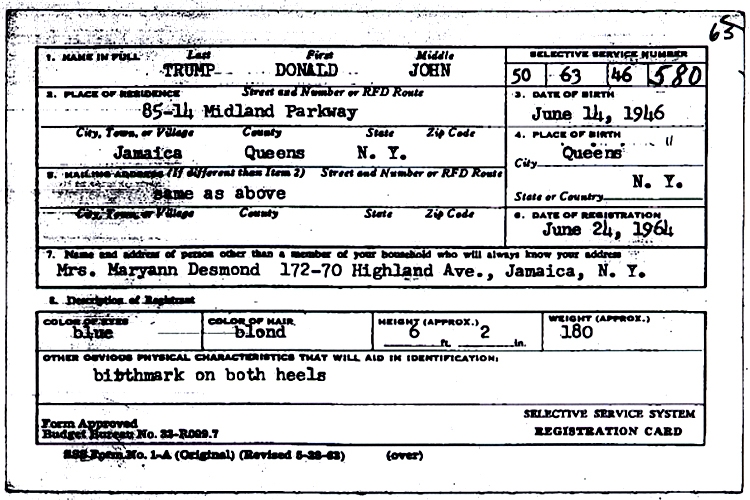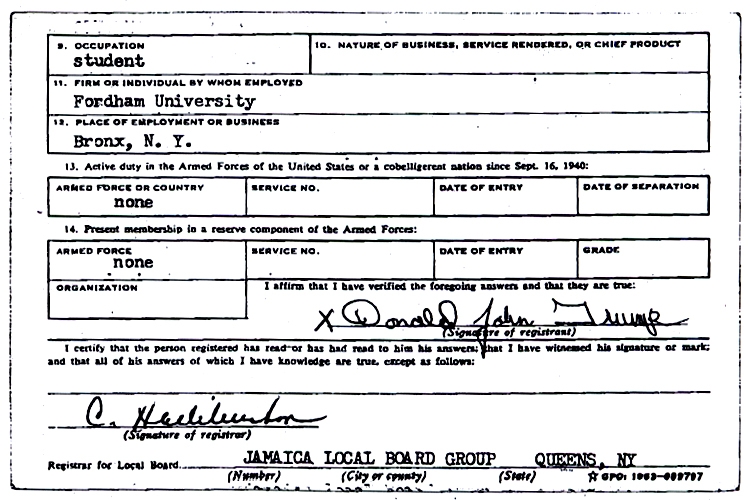Deferments Helped Trump Dodge Vietnam
How the presidential candidate avoided combat

View Document
7/18/15 UPDATE: Now that Donald Trump has maligned Senator John McCain as a phony war hero who got himself captured in Vietnam, below you’ll find a reminder--which TSG published the last time the Republican claimed to be running for president--how Trump avoided military service.
The son of a wealthy real estate developer, Trump received four student deferments that were followed by a 1968 medical deferment that came a few months after he graduated from the University of Pennsylvania.
After denigrating McCain during remarks today at the Family Leadership Summit in Ames, Iowa, Trump faced reporters’s questions about his lack of service. Asked about the last of his five deferments, Trump said that his disqualifying medical condition was a bone spur in one of his feet (he could not remember which one). It is unknown on which golf course the injury was sustained.
APRIL 28, 2011--Despite Donald Trump’s claim this week that he avoided serving in the Vietnam War solely due to a high draft number, Selective Service records show that the purported presidential aspirant actually received a series of student deferments while in college and then topped those off with a medical deferment after graduation that helped spare him from fighting for his country, The Smoking Gun has learned.
 During a TV interview Tuesday morning, Trump--who spent his high school years enrolled at the New York Military Academy--said, “I actually got lucky because I had a very high draft number. I’ll never forget, that was an amazing period of time in my life.”
During a TV interview Tuesday morning, Trump--who spent his high school years enrolled at the New York Military Academy--said, “I actually got lucky because I had a very high draft number. I’ll never forget, that was an amazing period of time in my life.”
He went on to recall, “I was going to the Wharton School of Finance, and I was watching as they did the draft numbers and I got a very, very high number and those numbers never got up to.” The word “deferment” was not mentioned by Trump during his chat with the morning show hosts on WNYW, the Fox affiliate in New York City.
However, Selective Service records reveal that Trump, the fortunate son of a multimillionaire real estate baron, took repeated steps to avoid serving in Vietnam.
By the time his number (356) was drawn during the December 1, 1969 draft lottery, Trump had already received four student deferments and a medical deferment, according to military records on file with the National Archives and Records Administration. An extract of Trump’s Selective Service Classification record, seen here, was provided in response to a TSG records request.
In fact, the December 1969 draft lottery occurred about 18 months after Trump graduated from the University of Pennsylvania, where he studied business at the Wharton School. So, while claiming that he would “never forget” being at Wharton watching the draft numbers being drawn, the 64-year-old Trump seems to have misremembered, as candidates are fond of saying.
Trump obtained his first two Class 2-S student deferments in June 1964 and December 1965, when he was student at Fordham University in the Bronx. He was briefly reclassified as 1-A--or "available for military service"--in late-November 1966, but that classification was switched back to 2-S three weeks later.
Another 2-S deferment is dated January 16, 1968, just months before his graduation from UPenn (to which he transferred following his sophomore year at Fordham).
Following his UPenn graduation, Trump--no longer qualified for a 2-S deferment--was again briefly classified as available for service on July 9. However, three months later, on October 15, his classification was switched to 1-Y, which was given to men deemed qualified for military service “only in time of national emergency.”
The 1-Y classification came a month after Trump underwent an “Armed Forces Physical Examination,” according to Selective Service records, which note the results of the exam as “DISQ.” While the military records do not further detail why Trump was granted the 1-Y deferment, a 1992 biography of the businessman by journalist Wayne Barrett reported that Trump received a medical deferment following the September 17, 1968 exam.
Trump’s 1-Y classification stayed in effect until February 1, 1972 when it was changed to a 4-F classification (which covered registrants not qualified for military service). The change in classification was likely prompted by the military’s December 1971 decision to abolish the 1-Y classification.
The Selective Service records also include a copy of the registration card signed by Trump in June 1964, 10 days after he turned 18. The possible future Commander-in-Chief, it turns out, has birthmarks on both his heels. (3 pages)








Comments (75)